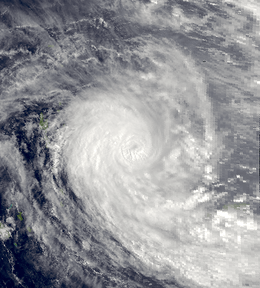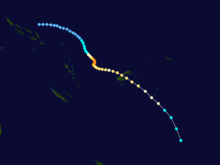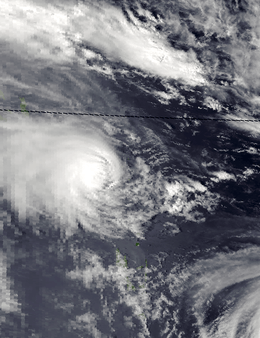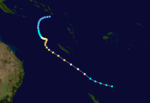1992–93 South Pacific cyclone season
 | |
| Season summary map | |
| First system formed | December 3, 1992 |
|---|---|
| Last system dissipated | April 6, 1993 |
| Strongest storm1 | Prema – 940 hPa (mbar), 185 km/h (115 mph) (10-minute sustained) |
| Total depressions | 12 |
| Tropical cyclones | 10 |
| Severe tropical cyclones | 6 |
| Total fatalities | None reported |
| Total damage | $18.5 million (1993 USD) |
| 1Strongest storm is determined by lowest pressure | |
1990–91, 1991–92, 1992–93, 1993–94, 1994–95 | |
| Related articles | |
The 1992–93 South Pacific cyclone season was a near average tropical cyclone season with ten tropical cyclones occurring within the South Pacific to the east of 160°E. The season officially ran from November 1, 1992, to April 30, 1993 with the first disturbance of the season forming on December 3 and the last disturbance dissipating on April 6.
During the season, tropical cyclones were monitored by the Tropical Cyclone Warning Centers (TCWC) in Nadi, Fiji, and in Wellington, New Zealand.[A 1] Whilst tropical cyclones that moved to the west of 160°E were monitored as a part of the Australian region by the Australian Bureau of Meteorology. Both the United States Joint Typhoon Warning Center (JTWC) and the Naval Western Oceanography Center (NWOC) issued unofficial warnings within the southern Pacific. The JTWC issued warnings between 160°E and the International Date Line whilst the NWOC issued warnings for tropical cyclones forming between the International Date Line and the coasts of the Americas. Both the JTWC and the NWOC designated tropical cyclones with a number and a P suffix with numbers assigned in order to tropical cyclones developing within the whole of the Southern Hemisphere. TCWC Nadi and TCWC Wellington both use the Australian Tropical Cyclone Intensity Scale, and measure windspeeds over a period of ten minutes, while the JTWC and the NWOC measured sustained winds over a period of one minute and use the Saffir–Simpson Hurricane Scale.
Seasonal summary

On July 1, 1992 the New Zealand Meteorological Service (TCWC Wellington) was broken up and became the Meteorological Service of New Zealand and the National Institute of Water and Atmospheric Research.[1]
Ahead of the 1992–93 season it was predicted that the season would feature a below average amount of tropical cyclones, after six tropical cyclones had affected Vanuatu during the previous season.[2] During that season as no systems had affected the archipelago, the VMS had started to hope that no tropical cyclones would impact the archipelago during the season.[2] However, during March 29 – 30, Cyclone Prema affected the Shepherd, E'pi and Efate where it caused widespread damage to buildings and crops.[3]
Storms
Severe Tropical Cyclone Joni
| Category 4 severe tropical cyclone (Australian scale) | |||
|---|---|---|---|
| Category 3 tropical cyclone (SSHWS) | |||
| |||
| Duration | December 3 – December 14 | ||
| Peak intensity | 165 km/h (105 mph) (10-min) 940 hPa (mbar) | ||
At the start of December a shallow tropical depression developed, along the South Pacific Convergence Zone, in the vicinity of the Tuvaluan islands.[4] Over the next few days the system persisted near Tuvalu, before it started to move south-eastwards and develop further during December 5.[4]
During December 6, the United States Joint Typhoon Warning Center designated the system as Tropical Cyclone 03P and initiated advisories, while the system was located on the 180th meridian about 180 km (110 mi) to the southeast of Funafuti in Tuvalu.[5] Over the next couple of days the system slowly deepened as it organised further and caused gale to storm force winds, on the island of Niulakita and strong squally winds over the rest of Tuvalu.[4] During December 7, the Fiji Meteorological Service (FMS) reported that the depression, had developed into a Category 1 tropical cyclone on the Australian tropical cyclone intensity scale and named it Joni.[4] After it had been named the system passed near Niulakita, as it was steered towards the southwest by a low-middle level flow and intensified further.[4][6]
Joni was subsequently classified as a Category 3 severe tropical cyclone on the Australian scale by the FMS during the next day, after an eye had become apparent in satellite imagery.[4][7] The system subsequently slowed down and started to recurve and move southwards towards Fiji, due to a weakness in the subtropical ridge of high pressure.[6][7] Early on December 10, the FMS reported that Joni had peaked as a Category 4 severe tropical cyclone, with 10-minute sustained wind speeds of 165 km/h (105 mph).[7] The JTWC also reported at around this time that the system had peaked with 1-minute sustained wind speeds of 205 km/h (125 mph), which made it equivalent to a Category 3 hurricane on the Saffir–Simpson hurricane wind scale.[5] During that day Joni passed near or over the Fijian island groups of Yasawa and Mamanuca, before it passed about 55 km (35 mi) to the west of the Fijian main island: Viti Levu.[4] After it had to the west of Viti Levu, Joni moved south-eastwards and passed over Kadavu during December 11, as it started to weaken and transition into an extratropical cyclone.[4][6] The system was subsequently absorbed by a mid-latitude trough of low pressure to the northeast of Gisborne New Zealand during December 14.[4][7]
Severe Tropical Cyclone Kina
| Category 3 severe tropical cyclone (Australian scale) | |||
|---|---|---|---|
| Category 4 tropical cyclone (SSHWS) | |||
| |||
| Duration | December 23 – January 6 | ||
| Peak intensity | 150 km/h (90 mph) (10-min) 955 hPa (mbar) | ||
On December 23, TCWC Nadi started to monitor a tropical depression, that had developed within the monsoon trough about 340 km (210 mi) to the northeast of Honiara on the Solomon Island of Guadalcanal.[8] Over the next few days the depression gradually developed further as it moved slowly towards the south-southeast, before during December 26, the JTWC designated the system as Tropical Cyclone 07P and started to issue warnings on the system as it had become equivalent to a tropical storm.[9][10] During the next day, the system appeared to slightly relax before it resumed developing from about 1200 UTC with TCWC Nadi naming it Kina later that day, after the depression developed into a category one tropical cyclone.[8][7] Early on December 28, the JTWC reported that the system had become equivalent to a category 1 hurricane on the SSHWS.[9] During that day Kina continued to develop as it moved south-eastwards, before it turned towards the south and became slow moving later that day, before the JTWC reported during the next day that Kina had reached its peak intensity with 1-minute sustained wind speeds of 220 km/h (140 mph) which made it a category 4 hurricane on the SSHWS.[9][5] Later that day TCWC Nadi reported that Kina had peaked as a category 3 severe tropical cyclone with 10 – minute sustained wind speeds of 150 km/h (90 mph).[8][7]
Tracked towards the capital, Suva, where it caused significant damage and reports of casualties.[11] The main bridge and secondary bridge to the international airport at Nadi collapsed and subsequently delayed the evacuation of tourists from the island, with emergency ferry services forced to ferry passengers from buses waiting on either side of the river bank.
Throughout Fiji, 23 people were killed and damage amounted to $100 million.[12]
Severe Tropical Cyclone Nina
| Category 3 severe tropical cyclone (Australian scale) | |||
|---|---|---|---|
| Category 1 tropical cyclone (SSHWS) | |||
| |||
| Duration | January 1 – January 5 | ||
| Peak intensity | 140 km/h (85 mph) (10-min) 960 hPa (mbar) | ||
During January 1, Nina crossed Rennell and Bellona in the Solomon Islands and moved into the South Pacific basin.[13] intensity with
Tropical Depression 08P
| Tropical depression (Australian scale) | |||
|---|---|---|---|
| Tropical storm (SSHWS) | |||
| |||
| Duration | January 1 – January 3 | ||
| Peak intensity | 85 km/h (50 mph) (1-min) 991 hPa (mbar) | ||
On January 1, TCWC Nadi reported that a tropical depression had developed about 500 km (310 mi) to the east of Alofi in Niue.[14] During that day the depression moved towards the east before on January 2, the NPMOC designated it as Tropical Cyclone 08P.[5][14] During that day 08P started to move towards the southeast through the Cook Islands before the NPMOC reported that it had peaked with 1-minute sustained windspeeds of 45knots. During January 3, 08P rapidly degenerated into an extratropical low about 405 km to the southeast of Papeete in French Polynesia.
Tropical Depression 09P
| Tropical depression (Australian scale) | |||
|---|---|---|---|
| Tropical depression (SSHWS) | |||
| |||
| Duration | January 11 – January 13 | ||
| Peak intensity | 65 km/h (40 mph) (10-min) | ||
Tropical Depression 09P existed from January 11 to January 13.
Severe Tropical Cyclone Lin
| Category 3 severe tropical cyclone (Australian scale) | |||
|---|---|---|---|
| Category 2 tropical cyclone (SSHWS) | |||
| |||
| Duration | January 30 – February 5 | ||
| Peak intensity | 120 km/h (75 mph) (10-min) 970 hPa (mbar) | ||
A tropical depression developed on January 30, about 365 km (225 mi) to the northeast of Apia, Samoa.[15][16]
Tropical Cyclone Mick
| Category 1 tropical cyclone (Australian scale) | |||
|---|---|---|---|
| Tropical storm (SSHWS) | |||
| |||
| Duration | February 3 – February 9 | ||
| Peak intensity | 85 km/h (50 mph) (10-min) 987 hPa (mbar) | ||
A shallow tropical depression developed during February 3, within the South Pacific Convergence Zone about 170 km (105 mi) to the north-west of American Samoa.[7][17] Over the next few days the system gradually developed further, as it moved south-westwards and passed near the Tongan island of Keppel during February 5.[17] Later that day the NPMOC initiated advisories on the system and designated it as Tropical Cyclone 17P, while it was located about 520 km (325 mi) to the northeast of Nukuʻalofa.[5] The system subsequently passed through the islands of central Tonga and was named Mick by the FMS during February 6, after it had developed into a Category 1 tropical cyclone.[17]
After being named the system continued to intensify during that day, before both the NPMOC and the FMS reported that Mick had peaked with winds of 85 km/h (50 mph).[7][5] As Mick continued to move south-westwards further development was suppressed, by cooler waters and vertical wind shear as it accelerated through Fiji's Lau Islands.[17] The system subsequently weakened gradually, before it rapidly lost its tropical characteristics, as it moved into MetService's area of responsibility during February 9.[17][18] Mick's extratropical remnants were subsequently last noted during February 11, as they passed about 250 km (155 mi) to the northwest of Gisborne on New Zealand's east coast.[7] As Mick was only a small and weak system, it only caused a minimal amount of damage on the islands in Tonga and Fiji that it passed near or over.[17]
Tropical Cyclone Nisha
| Category 2 tropical cyclone (Australian scale) | |||
|---|---|---|---|
| Category 1 tropical cyclone (SSHWS) | |||
| |||
| Duration | February 9 – February 16 | ||
| Peak intensity | 110 km/h (70 mph) (10-min) 975 hPa (mbar) | ||
On February 9, the FMS started to monitor a depression that had developed, just to the southwest of Pukapuka in the Northern Cook Islands.[19]
Tropical Cyclone Oli
| Category 1 tropical cyclone (Australian scale) | |||
|---|---|---|---|
| Tropical storm (SSHWS) | |||
| |||
| Duration | February 14 – February 20 | ||
| Peak intensity | 75 km/h (45 mph) (10-min) 990 hPa (mbar) | ||
Oli existed from February 14 to February 20.
Severe Tropical Cyclone Polly
| Category 3 severe tropical cyclone (Australian scale) | |||
|---|---|---|---|
| Category 3 tropical cyclone (SSHWS) | |||
| |||
| Duration | February 27 – March 9 | ||
| Peak intensity | 155 km/h (100 mph) (10-min) 945 hPa (mbar) | ||
Polly existed from February 27 to March 9.
Tropical Cyclone Roger
| Category 1 tropical cyclone (Australian scale) | |||
|---|---|---|---|
| Tropical storm (SSHWS) | |||
| |||
| Duration | March 20 (Entered basin) – March 22 | ||
| Peak intensity | 75 km/h (45 mph) (10-min) 985 hPa (mbar) | ||
Roger entered the basin on March 20 and dissipated on March 22.
Severe Tropical Cyclone Prema
| Category 4 severe tropical cyclone (Australian scale) | |||
|---|---|---|---|
| Category 4 tropical cyclone (SSHWS) | |||
| |||
| Duration | March 24 – April 6 | ||
| Peak intensity | 185 km/h (115 mph) (10-min) 940 hPa (mbar) | ||
Prema existed from March 24 to April 6.
Season effects
This table lists all the storms that developed in the South Pacific to the east of longitude 160°E during the 1992–93 season. It includes their intensity on the Australian Tropical cyclone intensity scale, duration, name, landfalls, deaths, and damages. All data is taken from the warning centers from the region unless otherwise noted.
| Name | Dates active | Peak classification | Sustained wind speeds |
Pressure | Land areas affected | Damage (USD) |
Deaths | Refs |
|---|---|---|---|---|---|---|---|---|
| Joni | December 3 – 13 | Category 4 severe tropical cyclone | 175 km/h (110 mph) | 940 hPa (27.76 inHg) | Tuvalu, Fiji | $1 million | 1 | [20] |
| Kina | December 26 – January 5 | Category 3 severe tropical cyclone | 150 km/h (95 mph) | 955 hPa (28.20 inHg) | Fiji, Tonga | $110 million | 26 | [8] |
| Nina | January 1 – 5 | Category 3 severe tropical cyclone | 140 km/h (85 mph) | 960 hPa (28.35 inHg) | Queensland, Solomon Islands Rotuma, Wallis and Futuna, Tonga | [13] | ||
| 08P | January 1 – 3 | |||||||
| 09P | January 11 – 13 | |||||||
| Lin | ||||||||
| Mick | February 3 – 9 | Category 1 tropical cyclone | 85 km/h (50 mph) | 987 hPa (29.15 inHg) | Tonga, Fiji, New Zealand | Minimal | None | [17] |
| Nisha | February 9 – 16 | Category 2 tropical cyclone | 110 km/h (70 mph) | 975 hPa (28.79 inHg) | Cook Islands | None | None | [19] |
| Oli | ||||||||
| Polly | February 27 – March 9 | Category 3 severe tropical cyclone | 155 km/h (100 mph) | 945 hPa (27.91 inHg) | Solomon Islands, New Caledonia New Zealand | |||
| Roger | March 20 – 27 | Category 2 tropical cyclone | 95 km/h (60 mph) | 985 hPa (29.09 inHg) | Solomon Islands, Australia New Caledonia | |||
| Prema | March 24 – April 6 | Category 4 severe tropical cyclone | 185 km/h (115 mph) | 940 hPa (27.76 inHg) | Vanuatu, New Caledonia | $60 million | [21] | |
| Season Aggregates | ||||||||
| 12 systems | November 23 – April 6 | 185 km/h (115 mph) | 940 hPa (27.76 inHg) | |||||
See also
- Atlantic hurricane seasons: 1992, 1993
- Pacific hurricane seasons: 1992, 1993
- Pacific typhoon seasons: 1992, 1993
- North Indian Ocean cyclone seasons: 1992, 1993
Notes
References
- ↑ Steiner, J Thomas; Martin, John R; Gordon, D Neil; Grant, Malcolm A (September 1991). "Commercialization in the provision of meteorological services in New Zealand". Meteorological Applications (Royal Meteorological Society) 4 (3): 247–257. doi:10.1017/S1350482797000480.
- 1 2 Taiki, Henry; West, Steve (April 2, 1993). Tropical Cyclone Prema – A brief perspective from the meteorological office (PDF) (Report). Vanuatu Meteorological Service. Archived from the original on May 2, 2014. Retrieved May 2, 2014.
- ↑ Kilman, Sato (April 19, 1993). Tropical cyclone Prema: damage assessment/disaster relief operations interim report (PDF) (Report). Port Vila, Vanuatu: National Disaster Management Office. Archived from the original on November 5, 2015. Retrieved November 5, 2015.
- 1 2 3 4 5 6 7 8 9 Tropical Cyclone Joni, December 3–14, 1992 (Report). Fiji Meteorological Service. May 20, 1996. Archived from the original on December 5, 2015. Retrieved December 5, 2015.
- 1 2 3 4 5 6 Joint Typhoon Warning Center (1994). Annual Tropical Cyclone Report: 1993 (PDF) (Report). United States Navy, United States Air Force. p. 216. Retrieved January 31, 2013.
- 1 2 3 Darwin Regional Specialised Meteorological Centre (1992). "December 1992" (PDF). Darwin Tropical Diagnostic Statement (Australian Bureau of Meteorology) 11 (12): 2. ISSN 1321-4233. Archived from the original on December 6, 2015. Retrieved December 6, 2015.
- 1 2 3 4 5 6 7 8 9 RSMC Nadi – Tropical Cyclone Centre, TCWC Brisbane, TCWC Wellington (May 22, 2009). "TCWC Wellington Best Track Data 1967–2006". Fiji Meteorological Service, Meteorological Service of New Zealand Limited, Australian Bureau of Meteorology. International Best Track Archive for Climate Stewardship.
- 1 2 3 4 Prasad, Rajendra; Nadi Tropical Cyclone Warning Center (May 20, 1996). Tropical Cyclone Kina, December 23, 1992 – January 5, 1993 (Tropical Cyclone Report 92/1). Fiji Meteorological Service. Archived from the original on March 6, 2013. Retrieved March 21, 2013.
- 1 2 3 Joint Typhoon Warning Center; Naval Pacific Meteorology and Oceanography Center. "Tropical Cyclone 07P (Kina) best track analysis". United States Navy, United States Air Force. Archived from the original on March 25, 2013. Retrieved March 25, 2013.
- ↑ Joint Typhoon Warning Center; Naval Pacific Meteorology and Oceanography Center (1993). Annual Tropical Cyclone Report: 1993 (PDF) (Report). United States Navy, United States Air Force. pp. 165 — 170, 216 — 224. Retrieved January 31, 2013.
- ↑ http://www.reliefweb.int/rw/RWB.NSF/db900SID/ACOS-64DDYY?OpenDocument
- ↑ http://www.apfm.info/pdf/case_studies/cs_fiji.pdf
- 1 2 Tropical Cyclone Nina, December 21, 1992 – January 4, 1993 (Report). Fiji Meteorological Service. May 20, 1996. Archived from the original on December 5, 2015. Retrieved December 5, 2015.
- 1 2 Beven, Jack (1993-01-07). "Weekly tropical cyclone summary #74 (December 27, 1992 – January 3, 1993)". Google Groups. Archived from the original on 4 June 2011. Retrieved 2011-07-07.
- ↑ https://groups.google.com/forum/#!topic/sci.geo.meteorology/9CTS_CYThjw
- ↑ Goodge, Grant W (ed.). "Storm Data and Unusual Weather Phenomena: January 1993" 35 (1). National Climatic Data Center: 69. Archived from the original (PDF) on December 12, 2015. Retrieved December 20, 2015.
- 1 2 3 4 5 6 7 Tropical Cyclone Mick, February 3–9, 1993 (Report). Fiji Meteorological Service. May 20, 1996. Archived from the original on December 5, 2015. Retrieved December 5, 2015.
- ↑ Beven, Jack (February 16, 1993). "Weekly tropical cyclone summary #80 (February 7 – 14, 1993)". Retrieved December 5, 2015.
- 1 2 Tropical Cyclone Nisha, February 11–16, 1993 (Report). Fiji Meteorological Service. May 20, 1996. Archived from the original on December 5, 2015. Retrieved December 5, 2015.
- ↑ "Cyclone toll in Solomons, Fiji, PNG, Tonga still rising". The Canberra Times. January 6, 1993. p. 3. Retrieved December 6, 2015.
- ↑ Unattributed (1993). "Vanuatu Cyclone Perma Mar 1993 UNDHA Information Reports 1–5". Reliefweb. Archived from the original on 2010-08-02. Retrieved 2010-08-02.
External links
- World Meteorological Organization
- Australian Bureau of Meteorology
- Fiji Meteorological Service
- Meteorological Service of New Zealand
- Joint Typhoon Warning Center




















